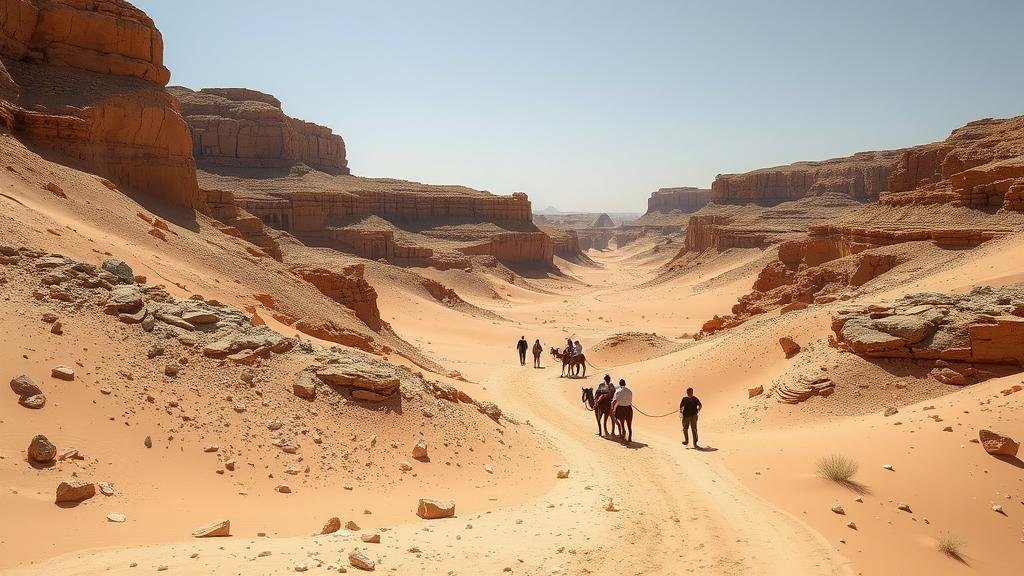Tracking ancient routes used by Bedouins to hide treasures from invading armies.
Tracking Ancient Routes Used by Bedouins to Hide Treasures from Invading Armies
The history of the Bedouins, the nomadic tribes of the Arabian Peninsula and surrounding areas, is rich with tales of survival, resilience, and intricate knowledge of their harsh environment. Among these narratives, the practice of hiding treasures from invading armies stands out not only as a testament to their ingenuity but also as a reflection of the tumultuous historical landscape in which they lived. This article delves into the ancient routes used by Bedouins for concealing treasures, examining the motivations, techniques, and historical contexts that shaped these practices.
The Historical Context of Bedouin Treasure Hiding
Throughout history, the Bedouins faced invasions from various armies seeking to expand their territories. For example, during the early Islamic conquests (circa 634-644 CE), Bedouin tribes would often need to protect their possessions from both foreign invaders and rival tribes. In times of conflict, they would resort to burying or concealing their valuables–such as gold, silver, and spices–instrategic locations known only to them.
One well-documented event occurred in the 12th century when the Crusaders invaded the region. The Bedouins utilized their vast and intimate knowledge of the surrounding deserts to shield their treasures from foreign forces. This keen awareness of the landscape enabled them to create intricate routes that could be used for hiding and later retrieving these precious assets.
Routes and Techniques for Concealment
Key Regions and Routes Used
To understand how treasures were hidden, it is essential to explore the specific routes and locations utilized by Bedouins. The following areas are of particular significance:
- The Sinai Peninsula: Known for its rugged geography, the Sinai was often employed to hide treasures due to its natural caves and caverns.
- The Empty Quarter (Rub al Khali): This vast desert plays a crucial role in Bedouin history, with its shifting sands and dunes providing excellent opportunities for concealment.
- The Hijaz Mountains: The mountainous regions were not only strategic hideouts but also offered a temperate climate for storing goods.
Concealment Techniques
Also to selecting remote locations, Bedouins employed various techniques for concealing treasures, including:
- Burying valuables: Burials were common, with specific landmarks serving as markers for retrieval in the future.
- Creating false trails: To mislead potential thieves, Bedouins would create decoy paths, leading away from hidden treasures.
- Using natural elements: Treasures were often placed in containers that blended into their surroundings, such as inside hollowed tree trunks or under natural stone formations.
Modern-Day Significance and Archaeological Efforts
In recent years, the study of ancient Bedouin routes has gained considerable attention. Archaeologists and historians have begun to use modern technology such as Geographic Information Systems (GIS) and ground-penetrating radar to uncover hidden treasures and study the strategic routes taken by the Bedouins. application of these technologies has led to significant discoveries, including treasure caches that date back centuries.
Real-World Implications
Understanding the ancient treasure-hiding practices of Bedouins has profound implications for contemporary societies, including:
- Cultural Preservation: Documenting these ancient paths contributes to our understanding of Bedouin culture and their interactions with the environment.
- Tourism Development: The historical trails and locations can serve as tourist attractions, promoting cultural tourism in the region.
- Security Strategies: Modern nations can learn from Bedouin methods of concealment and strategic planning in the realm of security and resource management.
Actionable Takeaways
The fascinating history of Bedouins and their treasure-hiding routes offers valuable lessons for both historians and contemporary practitioners. Here are a few key takeaways:
- Recognize the significance of oral traditions and local knowledge in preserving historical practices.
- Explore opportunities for using technology to uncover and study historical trade routes and concealment practices.
- Consider the cultural implications of these practices in modern contexts, particularly in tourism and heritage preservation.
To wrap up, the ancient routes utilized by Bedouins for hiding treasures reveal a complex interplay of survival tactics, environmental knowledge, and historical context. As we continue to investigate these routes and techniques, we deepen our understanding of Bedouin culture and the adaptive strategies they employed in the face of adversity.



